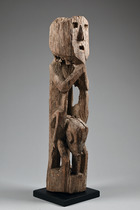Figure équestre · Népal (occidental) - Karnali · ID: 3048556
Description
heavily eroded wood with remains of white painting, base
This figure is depicted sitting on an elephant. According to Goy, the
motif of the horseman is frequently used by carvers of the Jumla area
(district in Karnali province) to depict dignitaries. As a crowning
feature on high posts, equestrian figures were used to protect bridge
crossings, as evidenced by a photograph by G. Krausskopf (Goy &
Krauskopff, Milan 2009, pp. 70 f., ill. 47-48).
Until today this archaic wooden sculptures are carved and dedicated by shamans.
They can be found in a wide variety of places, in shamanistic temples or on house roofs, at passes, crossroads, the confluence of rivers, near springs or in fields.
The figures serve as protective deities who are supposed to protect people from all evil and from all dangers. Placed at bridges, they ensure the purity of the water and safe passage. At crossroads, where nefarious spirits congregate, they protect travellers and bring luck for their undertakings. Planted in fields, they are to watch over the earth and the grain.
Shrines dedicated to the ancestors are found at the edges of villages. They take the form of simple shelters with gabled roofs. Inside, dozens of figures can be found heaped up. Often the seated or upright figure has its hands folded in prayer.
L’objet Figure équestre numéro d’objet 3048556, a fait partie de l’enchère 97e Vente aux enchères en 6 novembre 2021 pour la dernière fois le Zemanek-Münster Hôtel des ventes et avait le numéro de lot 9.
Vous trouverez d’autres Figures et autres types d’objets populaires sur nos pages thématiques associées. Notre page sur le thème Art asiatique pourrait également vous intéresser.
Littérature comparée
Stadt Offenburg (Hg.) Als die Götter noch jung waren, Offenburg 2002, p. 22 ff. Goy, Bertrand & Gisèle Krauskopff, "Wood Sculpture in Nepal, Jokers and Talismans", Collection of Max Itzikovitz, Milan 2009, p. 61, Pl. 13





